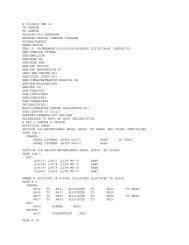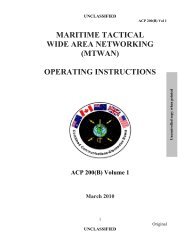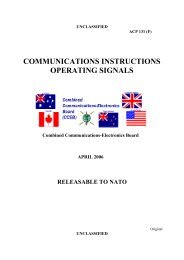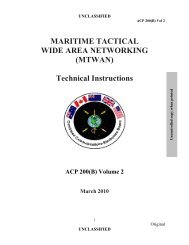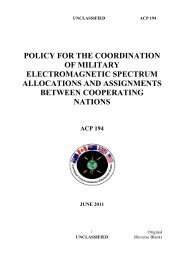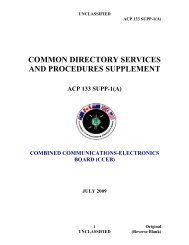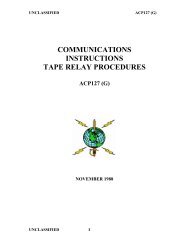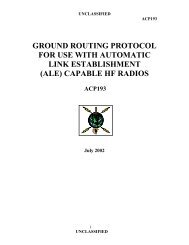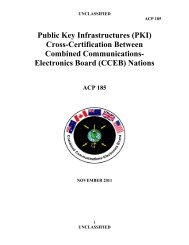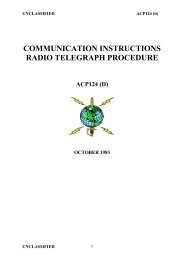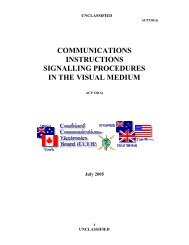ACP 201
ACP 201
ACP 201
You also want an ePaper? Increase the reach of your titles
YUMPU automatically turns print PDFs into web optimized ePapers that Google loves.
Uncontrolled Copy When Printed<br />
UNCLASSIFIED<br />
<strong>ACP</strong> <strong>201</strong><br />
a. COI – The term Community of Interest (COI) refers to a collaborative group of<br />
users within a domain that must exchange information in pursuit of its shared goals,<br />
interests, missions, or business processes and therefore must have shared vocabulary<br />
for the information it exchanges.<br />
b. Tier 1 Network - A coalition capability or application that can be accessed from a<br />
national C2 network. At Tier 1, allied nations will exchange information between<br />
permanently inter-connected national classified C2 systems over multiple security<br />
domains.<br />
c. Tier 2 Network - A coalition capability or application that is not<br />
integrated/connected to national C2 systems and can be accessed from a stand-alone<br />
C2 system. At Tier 2, information sharing at all command levels within a coalition<br />
or with nations without national C2 systems will be by means of standalone<br />
networks and systems.<br />
d. Web Services - A standardized means of integrating web-based applications using<br />
open standards over an Internet Protocol backbone. Web services allow applications<br />
developed in various programming languages and running on various platforms to<br />
exchange data without intimate knowledge of each application‘s underlying IT<br />
systems.<br />
MODUS OPERANDI<br />
117. In addition to the TG/TF COMPLAN, high-level guidance for Information Management<br />
(IM) is normally articulated in the Information Management Plan (IMP). The Operational or<br />
Tactical Commander will also stipulate the tactical level IM requirements in an OPTASK IM,<br />
including the Information Dissemination Plan (IDP). Delivery of tactical messages within the<br />
TF/TG must follow the IDP using the C2 medium specified.<br />
118. The use of TCP/IP based tools is encouraged and should be used wherever possible to<br />
facilitate MNTG coordination and reduce voice circuit loading. Many contemporary applications<br />
however, have some inherent limitations that make the use of voice circuits the preferred<br />
communications path in certain situations.<br />
119. In general, voice circuits should be used to issue orders whilst chat and e-mail should be<br />
used to pass information and provide coordinating instructions. There are occasions when critical<br />
information must be expeditiously directed to, and acknowledged by, a specific person as opposed<br />
to a proxy. Such occasions will also require a high degree of confidence in both sender and<br />
receiver identity. While coordination of these types of events may be accomplished via voice, e-<br />
mail or chat, executive orders must be passed via the appropriate voice circuit. The conduct of<br />
these activities must be clearly articulated prior, by the Commander in the OPTASK IM, taking<br />
into consideration information management best practices. Information relating to the order may<br />
be passed via chat or e-mail to support and / or reinforce the voice transmission. Orders will not<br />
normally be given in a whisper box.<br />
1-4 Original<br />
UNCLASSIFIED<br />
(Reverse Blank)



